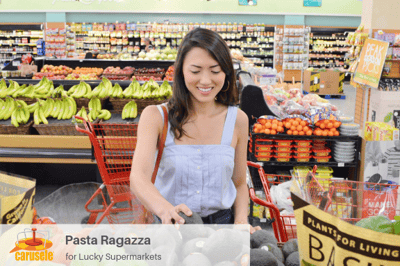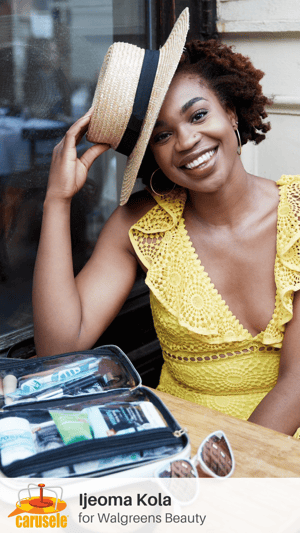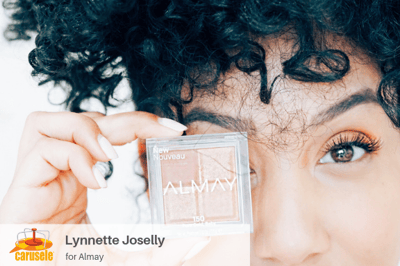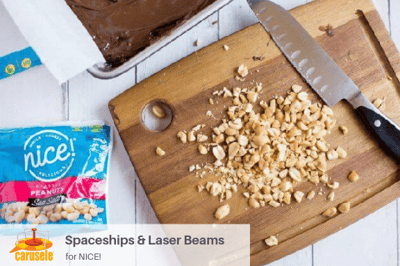The Key to Measuring the ROI of an Influencer CAMPAIGN
By nature, influencer marketing is built on channels and technology we don't own. We operate on borrowed platforms and, as a result, even the most sophisticated e-commerce tracking can follow every consumer a campaign might touch from impression to purchase. We CAN, however, make some pretty compelling educated guesses at the true ROI of influencer marketing campaigns if they're designed from the beginning to ensure the right data is captured, benchmarks set, and assumptions accepted.

EXECUTION NOTE: These don't all live in a silo. For example, Content Value can often be added on top of any of the sales return values. When rights are properly negotiated, the content generated by an influencer campaign should save the company from having to invest in certain types of content creation.Below, we're breaking down ways Carusele clients have been able to successfully measure a positive return on their influencer marketing investments.
Also, worth noting, any sales numbers you're able to get are bare minimums since influencer content, depending on the channel leveraged, can continue driving sales and acquisition for up to 2 or more years after it was originally published.
Influencer Marketing ROI Models

BEST FOR:
- E-commerce sales (requires tracked links; content amplification and pixel installation recommended)
- Retail sales (requires online + retail sales data or acceptable benchmark data)
- Lead-gen campaigns (requires online, customer acquisition form; content amplification and pixel installation recommended)
ROI from E-commerce Sales
Sorry folks. This one isn't as straightforward as you think. Too often, we see brands disappointed because they are trying to track ROI from influencer campaigns via last touch attribution, only to find a campaign that delivered millions of impressions resulted in just a few thousands clicks to their website. When just 1-5% of that traffic converts, the results can look pretty depressing.
Fear not! In our experience, less than 10% of sales from an influencer marketing campaign are the result of someone seeing an influencer post, clicking through, and immediately purchasing the product. TWEET THIS
To get a true picture of the e-commerce sales your campaign drove, we suggest employing an influencer + boosting model and leveraging the Facebook pixel to track sales. Don't believe the default attribution model Facebook uses when you install their pixel? Don't worry, we don't either. Instead, we leverage the data they provide to develop custom attribution models that make sense with your unique customer journey.
Stop Hitting the Boost Button - Learn How to Accurately Target Your Audience
ROI from E-commerce sales + Estimated Retail Lift
Best used for retailers, this model lets us use the data captured in the e-commerce sales model described above and apply it using a formula to estimate related in-store sales. It's pretty simply math. Say you tracked $10,000 in e-commerce sales from your campaign and you know the product your marketing consistently sees 20% of it's sales online and 80% of it's sales in-store, regardless of the marketing tactic employed. You can make a pretty educated guess that $10,000 is just 20% of the total sales the campaign drove. That means between e-commerce and in-store sales, your campaign likely delivered $50,000 in total sales for your company.

ROI from Correlated Sales Lift
This one requires a bit more complicated math. First, you have to find a quality benchmark. Ideally, your campaign and the benchmark data will have all other variables remain the same with the exception of the influencer effort. For example, this Revlon campaign used a benchmark period where the same value offer was running at the same retailer, on the same product, on the same day of the week, and received the same exact promotional tactics, the exception being one had influencer running, the benchmark period did not.
In that case, it was pretty easy to assume the additional sales could be attributed to the influencer program.
Can't find the cleanest benchmark? Identify all unique variables between the two. Then, run a correlation analysis on the daily delivery of key metrics like impressions or link clicks for each variable. You may need to shift those delivery metrics by a few days or a few weeks (keep in mind the average purchase cycle for your product) until you find the strongest correlation between all variables and sales. From there, you can start to piece together how much lift each tactic, including influencer, drove.
Extrapolated Sales Lift (regional or retail test)
This is a good way for CPG brands to understand the impact a large scale influencer program is having, absent of a good benchmark and time limited campaign period. Often times, we see CPG brands get discouraged when their small "test" campaigns don't reach the scale needed to move the needle on a national retail level. The issue comes down to scale. Running a smaller campaign targeting a specific retailer in a specific region can help these companies see the needle move and make some assumptions about how that lift percentage is also occurring on a national scale.
Estimated ROI from Customer Acquisition Value (Lead gen)

Some brands have a customer journey that includes building a relationship before a purchase is made, while others might not sell anything direct to consumers at all but make their money off the relationships they have with consumers (looking at you mobile app companies!). These companies typically already know the value of a new name in their database. Using the same data capture approach from our e-commerce sales model, and applying that value rather than a purchase value, we can still determine the ROI of an influencer campaign for a lead generation only campaign.
Impress Your C-Suite With These Influencer Marketing Metrics
Value Models for Influencer Marketing
BEST FOR:
- Evaluating spend against other marketing efforts
- Understanding additional benefit (beyond sales) the campaign has provided your company
Earned Media Value

One of the influencer industries most common "ROI" metrics, earned media value can be a good way to determine whether the investment was worthwhile when compared to other marketing efforts. The calculation is pretty easy. How many impressions did your influencer campaign get and what would it have cost to get those same quality impressions in another marketing channel? When determining that cost per impression, be sure to consider targeting, placement and content type.
WATCH OUT! A very common approach to calculating EMV in the influencer industry is to use the industry commonplace "max potential impressions" number. What's that? A ridiculously inflated and totally false metric that is in no way an indicator of actual campaign impact. Learn more: Death To Max Potential Impressions.
Time (Attention) per Dollar Spent

Attention isn't a new metric. It's been used to measure the value of TV advertising for years but it's rarely applied in the social space. Given influencer marketing is often being used by brands for top of funnel awareness, the same reason they're investing heavily in TV, it's the perfect metric to use when comparing your influencer marketing spend to other awareness driving efforts. To get to an attention metric for influencer marketing, you must first get comfortable with a few assumptions about the time spent with your influencer content. For example, our attention model, based on research into how long it takes a user to conduct certain actions on a social post values comments and shares at 16 seconds but likes or reactions at just 2 seconds.
Content Value
Similar to an attention model, you have to be comfortable with a few assumptions here but those assumptions can be based on facts. To calculate content value, you must look at the types of content assets generated in a campaign and, assuming you've secured appropriate rights, assign a value to each. To determine the value, consider what it would have cost you to procure a similar asset without paying a premium for the influencer's name or promotion of that asset. For example, we value the cost of an image at $150. Yes, a brand photo shoot can cost in the tens of thousands of dollars range, however, we also consider the fact that the brand isn't staging these photos themselves and may not use every single one. Even still, we know $150 is a pretty conservative value to place on the photos but we've found underestimating the value is better when presenting content value to the c-suite then mistakenly overvaluing them.
Curious how we could apply one or more of these ROI models for your brand? Contact our agency now using the form below to set up a free consultation.
-1.png?width=504&height=360&name=Carusele%20logo%20%C2%AE%20logo%20Color%20(2)-1.png)